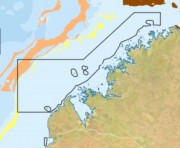Research
These short articles highlight the findings from ongoing scientific research within selected Marine Parks, including exciting new discoveries and ideas for future projects. If you are a scientist, read about how you can see your work featured in the Atlas.
Published on 28 October 2020
Ningaloo is famed for its corals, but new data has shone a light into the deeper waters and onto its sponge diversity, revealing the region is home to at least 16 new species previously unknown to science.
Published on 20 August 2020

A collaborative research voyage on the state-of the-art research vessel RV Investigator in 2018 explored Tasmania’s hidden seamounts (under-sea mountains). Extensive areas of deep-sea coral reefs supporting diverse communities were surveyed, mostly between 700 and 1500 metres below the sea surface. These seamount reefs represent a globally significant reference site to monitor recovery of deep-sea coral communities following the impacts sustained from bottom trawling in the 1990’s. We now better understand the biodiversity and distribution of these vulnerable ecosystems and their ability to recover from impacts such as a bottom trawling.
Published on 19 August 2020

The Great Australian Bight is one of the last strongholds of the charismatic Australian sea lion. Every year, researchers overcome the challenges of sheer cliffs and isolated rocky islands to count new pups, information that provides critical insights into how this threatened species is faring and how marine park managers can address existing and emerging threats.
Published on 28 July 2020

Acoustic mapping of one of northern Australia’s least studied coral shoals and searching for a shipwreck.
Published on 9 July 2020
Scientists have captured imagery of a newly discovered underwater landscape beneath the waves in Bass Strait, revealing a complex seabed of deep reefs that have been sustaining life for fish and other fauna for millennia. Using multibeam sonar, a team from Deakin University’s marine mapping group has scanned the seafloor in the Apollo Marine Park, south-west Victoria for the very first time.
Published on 28 May 2020

A re-survey of sites within the North-west Marine Park Network revealed an increase in fish biomass, richness, biomass of larger fishes, coral cover and macro-invertebrate density at Ashmore Reef Marine Park (IUCN Ia). Many of these changes were not recorded at fished reference sites, suggesting the strict sanctuary zoning is having a positive effect.
Published on 25 May 2020
In Autumn 2019, the Institute of Marine and Antarctic Science (IMAS) completed a two-week continuous multibeam mapping program in shelf waters of the Freycinet, Huon and Tasman Fracture Marine Parks to extend current knowledge of habitat distribution in these parks. In addition, several areas outside the park were mapped to provide external reference areas for the Tasman Fracture Marine Park. This mapping will underpin future biological inventory and monitoring programs.
Published on 8 May 2020
Fowlers Bay sits in the Great Australian Bight, immediately adjacent to the Great Australian Bight Marine Park. The bay is characterised by long stretches of wide, white sandy beaches and rocky headlands. To the east, they’re backed by towering sand dunes and to the west, immense 90 metre cliffs run for a 170 kilometre stretch. Exposed to south-easterly winds that drive large swells, the region is a popular haunt for the keen surfer and recreational fisherman. It is also known for its white shark population and thought to be prime habitat for juvenile white sharks.
Published on 22 April 2020

At the very edge of continental Australia lies a biological powerhouse. Isolated by hundreds of kilometres of ocean and visible only by a few tiny specks of land, Ashmore Reef is a unique place with a globally important role to play. A visionary scientific partnership, mixing new and old survey methods, is now delivering the data and insight Parks Australia needs to improve management of this ocean oasis.
Published on 6 November 2019

During a recent voyage in the Kimberley Marine Park we discovered fields of benthic siphonophores on the sea floor – one of the first records of this group in Australia.
